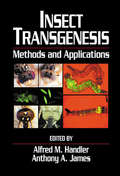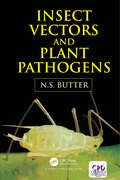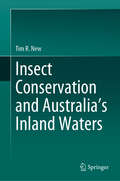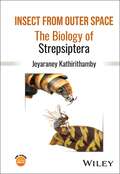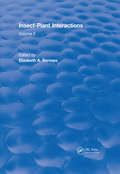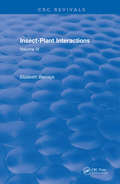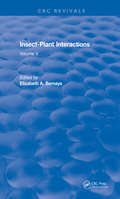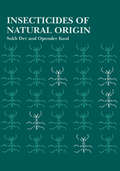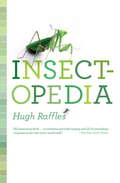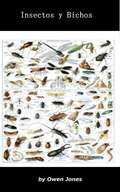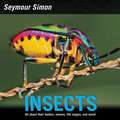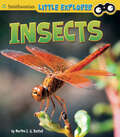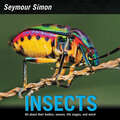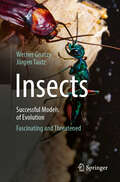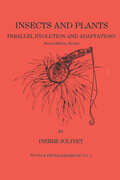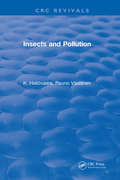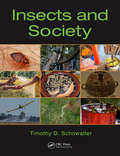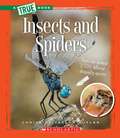- Table View
- List View
Insect Transgenesis: Methods and Applications
by Alfred M. Handler Anthony A. JamesImagine scientists controlling the transmission of certain diseases through the genetic modification of mosquitoes. Eradicating harmful insects without the use of pesticides. Or increasing the fertility of some insects who in turn eat harmful arthropods or even a plant pathogen. Those are just a few of the real-world applications of insect transgen
Insect Vectors and Plant Pathogens
by Nachhattar Singh ButterThe history of pathogens and vectors, unique symptoms of diseases and economic importance of important viral diseases have been dealt with in the introductory chapter of this book. While highlighting the role of arthropods, nematodes, and fungi; other agents of the spread of plant pathogens have also been included. Important aspects of insect vectors with direct bearing on transmission, i.e. vector identification, biology, feeding apparatus, and mechanism of spread including control of pathogens through vectors are covered comprehensively. As aphids and other hemipterous insects are major insect vectors, the book stresses on this order. There is a focus on the transmission of determinants under different categories of the transmission mechanism. The transmission determinant paradigm comprising coat protein and helper component has been expounded with recent cases. A brief description of new diseases at least one from each genus of plant viruses has been included in this compendium to elucidate the interaction of vector and virus. Phytoplasmal etiology of pathogens has been detailed separately on account of their importance. The transmission of plant viruses through insects with biting and chewing type of mouth parts has been discussed in detail as separate chapter. The latest research in the field of mites, nematodes, and fungi as vectors of plant viruses has been included. How the phytotoxemia is different from other crop disorders, has been critically explained with support from suitable and common examples of crop disorders. The book also highlights the effects of plant viruses on their vectors. An account of classification of plant viruses has also been given for better understanding of subject matter. Likewise, the information on the electron microscope along with its use has been included so as to define the procedure of examining sub-microscopic entities. The latest developments in the management of plant pathogens through vector management have been discussed with special reference to the use of biotechnology, crop protection, and plant resistance. <P><P>The book will be of value to the teachers and to researchers. It will also be useful for extension workers in managing crop disorders. Students and researchers of entomology, plant pathology, plant protection and virology disciplines will obtain the latest in the field, through this book.
Insect and Hydroponic Farming in Africa: The New Circular Food Economy (Agriculture and Food Series)
by Dorte Verner Afton Halloran Nanna Roos Surabian Maximillian Ashwill Saleema Vellani Yasuo KonishiWhile current agri-food production models rely on abundant supplies of water, energy, and arable land past practices point toward more affordable and sustainable paths. Different forms of insect farming and soilless crop farming, or hydroponics, have existed for centuries. In this report, the authors make a persuasive case that frontier agriculture, particularly insect and hydroponic farming, can complement conventional agriculture. As the report shows, insect and hydroponic farming can create jobs, diversify livelihoods, improve nutrition, and provide many other benefits in African and fragile, conflictaffected countries. Together with other investments in climate-smart agriculture, these technologies are part of a promising menu of solutions that can help countries move their land, food, water, and agriculture systems toward greater sustainability. This book is the World Bank's first attempt to look at insect and hydroponic farming as possible solutions to the world's climate and food and nutrition security crisis and may represent a new chapter in the Bank's evolving efforts to help feed and sustain the planet.
Insect conservation and Australia’s Inland Waters
by Tim R. NewThe first broad overview of conservation needs of Australia’s largely endemic freshwater insects, drawing on examples and information from many parts of the world to illustrate and develop needs and practical prospects for conservation in inland water environments. The wide variety of those environments in Australia and their diverse insect inhabitants – many of them highly localised and ecologically specialised and vulnerable - and threats to them is illustrated. Case histories demonstrate the different aspects of practical conservation management that may be possible in different contexts, and numerous references facilitate understanding by non-specialist readers and non-entomologist conservation managers and practitioners.
Insect from Outer Space: The Biology of Strepsiptera
by Jeyaraney KathirithambyComprehensive account of Strepsiptera biology, including their taxonomy, morphology, fine structure, physiology, and behaviour, ranging from genes to phylogeny Beautifully illustrated in full color throughout, with original up-to-date material from the author’s research collection, Insect from Outer Space: The Biology of Strepsiptera is the first book to provide a comprehensive guide to the unique biology of an intriguing group of parasitoids that, until relatively recently, have remained something of a mystery in terms of both phenotype and genotype. The author explores the exciting biology and life history of these extraordinary insect parasitoids. In addition, the book provides a history of each family, and an account of the questions surrounding the evolution of Strepsiptera, explaining their position within the phylogeny of insects. Written by a leading international expert in the field, this book includes information on: Strepsiptera, which are among the least species-rich insect parasitoids, but they parasitise hosts from seven orders and 36 families of insectsThe two examples of polyphensim that Strepsiptera exhibit are: i) free-living planidia that moult to endoparasitic larvae; and ii) the neotenic females of derived familiesAdult males are free-living, while females are free-living in primitive families, and are endoparasitic and neotenic in derived familiesMetamorphosis is a crucial process in the evolution of the sexually dimorphic Strepsiptera, and the neotenic females in derived families undergo a metamorphic transformation in the cephalothoracic regionDifferences in Strepsiptera life cycles between the suborders Mengenillidia (a more ancestral lineage) and Stylopidia (a recent suborder) Insect from Outer Space: The Biology of Strepsiptera is an essential reference work for entomologists and biologists alike who seek to unravel the secrets of these extraordinary creatures. The text is also an excellent learning resource for graduate and undergraduate students because the unique biology of Strepsiptera answers a wide range of biological questions.
Insect-Plant Interactions (Routledge Revivals #1)
by Elizabeth A. BernaysFirst Published in 1989, this book explores the relationship between plants and insects and the ways in which they interact with each other. Carefully compiled and filled with a vast repertoire of notes, diagrams, and references this book serves as a useful reference for students of oncology, and other practitioners in their respective fields.
Insect-Plant Interactions: Volume II (CRC Press Revivals #1)
by Elizabeth A. BernaysInsect-Plant Interactions is a series devoted to reviews across the breadth of the topic from cellular mechanisms to ecology and evolution. Articles are selected from areas of particular current interest or subjects that would especially benefit from a new review. It is hoped that the interdisciplinary selection in each volume will help readers to enter new fields of insect-plant interactions. Volume II contains six very different articles.
Insect-Plant Interactions: Volume IV (CRC Press Revivals #1)
by Elizabeth BernaysThis is the fourth volume of a series devoted to providing a comprehensive review of the study of plant-eating insects, covering topics ranging from biochemistry to ecology and evolution. Volume IV examines the status of mutualism, using the fig-insect interaction; phytosterols as important components of adaptive syndromes in herbivorous insects; methods utilized by plant-eating insects to detect compounds that deter feeding, including the various codes and how and why they vary; and the nature and significance of extrafloral nectaries in plants. The book also covers the varied roles of quinolizidines in plants, in addition to reviewing the controversial arena of plant stress and insect performance.Insect-Plant Interactions, Volume IV, is an important reference work for entomologists, zoologists, ecologists, and other scientists involved in studies with insect-plant interactions.
Insect-Plant Interactions: Volume V (CRC Press Revivals)
by Elizabeth A. BernaysPh.D.Volume 5 of "Insect-Plant Interactions" is a volume in a series that presents research in the field. Topics covered include chemical changes in plants as a result of insects feeding on their leaves, dynamic elements of the use and avoidance of host plants by tephritid flies as a result of the presence of other flies, floral volatiles in insect biology, endophytic fungi as mediators of plant insect interactions, the cost of chemical defence against herbivory, and life history traits on insect herbivores in relation to host quality. The book also presents the first available review on physicochemical conditions of the gut lumen from an ecological perspective.
Insecticides of Natural Origin
by Sukh DevNature has often provided valuable molecules either as lead compounds or for use in the fight against pests. Though a number of conference proceedings deal with the control of insects using natural products, there is no comprehensive account of what materials have been studied and what results have been obtained. Examining the material scattered across various disciplines, this book meets a recognized need by consolidating this information in one volume. The first section of the book covers chemistry and biological activity of major classes of naturally occurring pesticides, including the development of more potent insecticides based on natural lead-in structures. The second section consists of monographs on each compound by product.
Insectigations: 40 Hands-on Activities to Explore the Insect World (Young Naturalists)
by Cindy BlobaumFrom butterflies and beetles to crickets and katydids, these experiments, art projects, and games will bring out the entomologist in every kid. Activities include collecting and sketching insects, making a terrarium for observation, raising mealworms, using math to measure bug strength, gardening to attract butterflies and other insects, and making an insect amplifier. A unique insect board game helps kids learn fascinating bug facts while they play. Sidebars offer a look into the world of professional entomology, as well as gross facts about insects that will provide great playground trivia, including the USDA's guidelines for allowable insect parts per cup of food. Kids will learn that science is not just something to read about, but something they can observe and study in the world around them.
Insectivores and Bats (World of Animals: Mammals #9)
by Pat Morris Amy-Jane BeerThis book describes the habitats, habits, physical descriptions, status and facts about a variety of insectivores from Hedgehogs and Shrews to Moles and Bats.
Insectopedia: Ren Lei Xue Jia Guan Kan Chong Chong De 26 Zhong Fang Shi = Insectopedia
by Hugh RafflesMeditating on our relationship to bugs, Raffles set himself the task of writing an A to Z encyclopedia of a very personal sort, in which he records his thoughts on specific points of insect behavior, strange human behavior involving insects, and human's interests in insects' behaviors based on their own strange predilections. Chinese cricket fights, Himmler's grotesque characterization of Jews as lice, queer sex among insects and animals, and Sahelian locust swarms as another fatal threat in war-ravaged Niger, are among the unlikely and fascinating topics. Annotation ©2010 Book News, Inc. , Portland, OR (booknews. com)
Insectos y bichos (Como hacer... #65)
by Owen JonesInsectos y bichos Espero que encuentres esta información útil y rentable. La información en este ebook contiene varios aspectos, especialmente acerca de los insectos que viven en las casa y jardines, organizado en 16 capítulos de aproximadamente 500-600 palabras cada uno. Espero que sea interesante para todos aquellos que están preocupados por el contacto con los insectos y para quienes quieran usar algunos de los medios tradicionales para cuidarlos. Como un bonus adicional, concedo permiso para usar el contenido en tu propia página web, blog o boletín informativo, aunque sería mejor si lo reescribes con tus propias palabras primero. Puedes también dividir el libro y revender los artículos. De hecho, el único derecho que no tendrías es el revender o regalar el libro tal y como te fue entregado. Si tienes alguna retroalimentación, por favor dirígete a la compañía a la que compraste este libro. Probablemente podrás encontrar más libros que te gusten también.
Insectpedia: A Brief Compendium of Insect Lore (Pedia Books #8)
by Eric R. EatonA fun and fact-filled A–Z treasury for the insect lover in all of usInsectpedia introduces you to the wonders of the insect world while inviting you to make discoveries of your own. Featuring dozens of entries on topics ranging from murder hornets and the “insect apocalypse” to pioneering entomologists such as Margaret James Strickland Collins and Douglas Tallamy, this beautifully illustrated, pocket-friendly encyclopedia dispels many common myths about insects while offering new perspectives on the vital relationships we share with these incredible creatures.This entertaining collection celebrates the long and storied history of entomology, highlights our dependence on insects for food and ecosystem services, and explains the meaning behind various entomological terms. With Eric Eaton as your guide, you will circle the globe in search of African Toktokkies and Australian beer bottle beetles, and witness the peculiar spectacle of cricket fighting in Asia. Profiles of influential figures in entomology provide insights into the curious minds that animate this extraordinarily broad field of scientific inquiry, while the book’s portable size makes it the perfect travel companion no matter where your own entomological adventures may lead you.With captivating illustrations by Amy Jean Porter, Insectpedia is an engaging blend of insect facts and folklore that will inspire anyone who delights in the marvels of nature.Features a real cloth cover with an elaborate foil-stamped design
Insects
by Robin BernardIntroduces the body parts and other characteristics that are common to many kinds of insects
Insects
by Seymour SimonAward-winning science writer Seymour Simon explores the wonderful world of insects, with fascinating facts and stunning full-color photographs, in his latest nonfiction picture book. Readers will learn all about insects’ life stages, senses, bodies, and the many different kinds, including beetles, ladybugs, bees, butterflies, and more! This updated edition includes: Stunning full-color photographs Glossary Index Website and additional reading sources Supports the Common Core Learning Standards, Next Generation Science Standards, and the Science, Technology, Engineering, and Math (STEM) standards
Insects (Seymour Simon Science Ser.)
by Seymour SimonAward-winning science writer Seymour Simon explores the wonderful world of insects, with fascinating facts and stunning full-color photographs, in his latest nonfiction picture book. Readers will learn all about insects’ life stages, senses, bodies, and the many different kinds, including beetles, ladybugs, bees, butterflies, and more! This nonfiction picture book is an excellent choice to share during homeschooling, in particular for children ages 6 to 8. It’s a fun way to learn to read and as a supplement for activity books for children.This updated edition includes:Stunning full-color photographsGlossaryIndexWebsite and additional reading sourcesSupports the Common Core Learning Standards, Next Generation Science Standards, and the Science, Technology, Engineering, and Math (STEM) standards
Insects - Successful Models of Evolution: Fascinating and Threatened
by Jürgen Tautz Werner GnatzyIn the course of evolution, insects have developed an almost unbelievable variety of shapes and functional sophistication. The design of their exoskeleton is so imaginative and unusual, often even bizarre, that one can only marvel. The fact that insects can find design solutions for any problem, no matter how special, makes them extremely successful. They have thus become crucial links in the complex networks of nature. Impressive macro photographs and informative scanning electron-optical images provide an insight into the wealth of forms, beauty and function of the six-legged creatures. Fascinating texts accompany the pictures and explain, among other things, how the great diving beetle uses vertebrate hormones as knock-out drops when attacked by fish, the pine moth beetle locates distant forest fires, the bombardier beetle emits pulsed explosions with its firing apparatus or the blue butterfly caterpillar glamours ants. Insects play a crucial role in the ecosystems of our planet. Man-made environmental destruction is interfering with these cycles in a sensitive way. This endangers the survival of insects, with dramatic consequences for us humans as well.
Insects and Diseases of Mediterranean Forest Systems
by Timothy D. Paine François LieutierInsect and disease issues are often specific to the Mediterranean forest systems rather than shared with the temperate forests. In addition to the specific native insects and diseases, the forests are subject to the invasion of exotic species. The forests are also at risk from high degrees of human activity, including changing patterns of forest fires, land management activities, intensive plantation forestry using introduced timber species from other Mediterranean climate zones, and atmospheric deposition. Combined with elements of global climate change that may disproportionately affect Mediterranean climate systems, this creates a number of significant management issues that are unique to the Mediterranean forests. It is our goal that the information contained in this volume will contribute to understanding the unique aspects of Mediterranean forest systems and to protecting these critical resources.
Insects and Plants: Parallel Evolution & Adaptations, Second Edition
by Pierre JolivetInsects and plants, whether or not they coevolved, have intimate interrelationships. This book concisely yet thoroughly describes these phenomena. In one chapter the salient facts known about carnivorous plants are described. In another, ant and plant relationships are summarized as an introduction to this vast subject. Pollination, of great interest to agriculturists and horticulturists, is briefly explained without the complexities detailed in the massive literature on this topic. Many other subjects are discussed, such as the memory of adult butterflies, which enables them to return to their host plants in the case of the polyphagous species. The book is seeded with such thought-provoking discussions as prostitution among the orchids and botanical indigestion in some plants.
Insects and Pollution
by K. HeliovaaraInsects and Pollution provides a comprehensive overview of both the direct and indirect effects of pollution on insects and discusses the ecological and economic consequences of these changes. The book reviews studies on pollutant-induced changes in insects classified according to their trophic position, taxonomy, and developmental stage. These changes are considered on different spatial and temporal scales, in different climatic and vegetation zones, and in different habitats (with emphasis on coniferous forests). The book also describes the effects of a variety of pollutants on terrestrial and aquatic ecosystems. Other topics considered include the effects of pollutants on insect physiology, ecology and evolution, and updating and synthesizing data. Insects and Pollution is the first book to combine entomological and ecotoxicological perspectives to address the far-ranging effects of pollution on insects. It is essential reading for entomologists, ecotoxicologists, conservation biologists, and other professionals in the environmental sciences.
Insects and Society
by Timothy D. Schowalter"Insects are the most species-rich and important organisms on earth, and that’s why there are many university courses dedicated to the topic of Insects and Society. But, surprisingly, this is the first textbook specifically created for those courses. The content in this textbook is not only ideal for introductory courses, but it also is great for K12 instructors, insatiably curious children, and indeed anyone fascinated by insects and their impact on people." – Robert K. D. Peterson, Ph.D., Professor of Entomology, Montana State University and Past President, Entomological Society of America "Society is undervaluing the role of insects as pivotal drivers of ecosystem functioning and services. Addressing this deficit is a major merit of this book." – Teja Tscharntke, Professor and Head of the Agroecology Research Group at the University of Göttingen, Germany Insects are all around us, outweighing humanity by 17 times. Many are nuisances; they compete with us for food and carry some of our most devastating diseases. Many common pests have been transported worldwide by humans. Yet, some recent reports suggest dramatic declines in some important groups, such as pollinators and detritivores. Should we care? Yes, we should. Without insect pollinators we’d lose 35% of our global food production; without detritivores, we would be buried in un-decayed refuse. Insects are also critical sources for nutritional, medical and industrial products. A world without insects would seem a very different and unpleasant place. So why do insects inspire such fear and loathing? This concise, full-color text challenges many entrenched perceptions about insect effects on our lives. Beginning with a summary of insect biology and ecology that affect their interactions with other organisms, it goes on to describe the various positive and negative ways in which insects and humans interact. The final chapters describe factors that affect insect abundance and approaches to managing insects that balance their impacts. The first textbook to cater directly to those studying Insect and Society or Insect Ecology modules, this book will also be fascinating reading for anyone interested in learning how insects affect human affairs and in applying more sustainable approaches to "managing" insects. This includes K-12 teachers, undergraduate students, amateur entomologists, conservation practitioners, environmentalists, as well as natural resource managers, land use planners and environmental policy makers.
Insects and Spiders (A True Book: Animal Kingdom)
by Christine Taylor-ButlerSpiders and insects have a lot in common. Both are small animals with many legs, and most people do not like them. <P><P>A True Book: Animal Kingdom series introduces young investigative readers to animal species, their habitats, unique abilities as well as an up-close look at the dangers these animals face today and find out how humans can help keep all animal species from disappearing forever. This series includes an age appropriate (grades 3-5) introduction to curriculum-relevant subjects and a robust resource section that encourages independent study. <P><P>While these creepy crawlers are similar in many ways, they are actually different kinds of animals. Readers will discover what sets insects and spiders apart and learn how different species are suited for their many habitats around the world. Lexile Measure: 830
